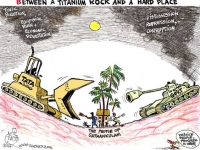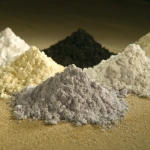Titanium or Water? Trouble brews in Southern India

More than 5,000 people converged this month in the southern Indian state of Tamil Nadu to protest a deal that set the stage for the state government to appropriate almost 10,000 acres of land and hand it over to Tata Steel Corporation, a subsidiary of India's largest conglomerate. The June 2007 agreement allows the giant company to mine ilmenite in Sathankulam, an agrarian pocket of India's coastal countryside.
This ilmenite, when processed, yields titanium metal and titanium dioxide (TiO2), both extremely valuable products. But many locals are refusing to sell out of concern that the ilmenite mining operations and loss of land will destroy their traditional way of life and despoil the environment. At least 40 percent of the population -- the landless and those engaged in household industries -- depend on farming palmyra trees for subsistence or supplemental income.
The Tamil Nadu government, has weighed in to side with Tata, and is threatening to seize the land by eminent domain. "The district administration, the state machinery and all its functionaries are engaged as unofficial real estate agents for Tata, and these days you'll see all of them trotting behind Tata officials trying to buy land," says S. Anandraj, chairman of the local self-government in Sathankulam. Anandraj is a member of the All India Anna Dravida Munnetra Kazhagam (AIADMK), a bitter political rival of the party ruling the state of Tamil Nadu.
What aggravates the locals even more is the lack of transparency by Tata and the government. Tata has promised to act fairly, but the June 2007 memorandum of understanding (MoU) between Tata and the state, as well as the survey numbers of lands to be acquired, remain closely guarded secrets.
| Titanium Conflicts Both titanium mining and processing have had a contentious history. In 1999, the indigenous people in the Okefenokee reservation in the southern U.S. state of Georgia, successfully fought off Dupont's 1999 attempt to mine titanium. In August 2006, villagers in central Vietnam forced titanium mining operations to halt after mining resulted in groundwater contamination and depletion. In the Kwale coastal area of Eastern Kenya, indigenous tribes have been fighting a pitched battle with titanium giant Tiomin to prevent it from mining titanium on ancestral lands. |
The Tamil Nadu Department of Industries denied this reporter's request under the Right to Information Act for a copy of the MoU. "Tata Steel," the department replied, "has raised their objection on the ground that it is an exclusive, privileged document of confidential nature and the disclosure of such information shall harm the commercial confidence and competitive position of the company."
National Priority?
Some 96 percent of the ilmenite extracted will be turned into titanium dioxide, which is extensively used as a pigment in plastics, paint, sun screen, food coloring and biomedical applications. The remainder is purified to titanium sponge, an intermediate which is further processed to titanium -- a corrosion-resistant metal that is half the weight of steel, but twice as strong and is especially valuable for applications in aircraft, space and other high-tech industries.
India's ilmenite resources are estimated at more than 21 percent of global deposits, but much of it has not been tapped. Instead the country imports most of its annual consumption of 70,000 tons of TiO2 as well as the titanium metal it uses for defense and space research. Meanwhile global demand for the metal is rising, indeed other big industrial countries -- like the U.S. and Russia -- have already stockpiled large quantities of the strategic metal, says Dr. Placid Rodriguez, visiting professor at the Indian Institute of Technology in Madras.
Rodriguez, who has headed various departments within India's nuclear and defense research establishments, says that India should tap into this growing market. "Our economic growth in this century will depend on bauxite, iron and titanium," he says.
Realizing the potential for future production should the sector open up, DuPont, the market leader in titanium dioxide pigment, already has set up outposts in India. And companies like Boeing have also started to look to India as a source of titanium metal. (Boeing's aircrafts are nearly 15 percent titanium in weight.)
For its part the Indian government is contemplating deregulation that would allow 100 percent foreign direct investment in mining and processing. This potentially lucrative new opportunity quickly attracted the attention of Tata, one of India's oldest and biggest companies. (According to its website, the Tata Group's businesses are now spread over seven business sectors, 98 companies and six continents. "It employs some 246,000 people and collectively has a shareholder base of over 2 million and market capitalization of $70 billion as of October 2007.")
The company sees titanium mining is an important opportunity for diversification. "For 100 years, Tata has remained a single mineral company with its emphasis on steel," explains Dr. S. Asokan, Tata Steel's executive-in-charge for the Titania project.
Tata's Plans for Sathankulam
But before Tata can proceed with the $625 million titanium project, it needs to secure the land and displace thousands of local farmers and small business people. As currently envisioned, the mining project involves land spread over six villages in Sathankulam, a 24-square mile area about 35 miles from the southern port city of Tuticorin; Tata hopes to expand by an additional 12 square miles over a 30-year period.
The complex operations will include a mineral processing plant to produce titanium dioxide pigment and a coal-fired thermal power plant. A seawater desalination plant to supply 16 million liters a day of fresh water, is planned for Kulasekarapattinam, a seaside fishing hamlet about 12 miles from the mining site. Tata will also set up tailing ponds that will hold up to 85 percent of the material mined in the form of slime (very fine sand) and coarse sand.
Each year, Tata plans to remove 500,000 tons of ilmenite-rich sands, with 53 percent titanium dioxide, from slightly more than half a square mile. For the first year, the operation will require more land to accommodate tailings ponds.
"Government will consider land acquisition [through eminent domain],"
says Tamil Nadu government Industries Secretary Shaktikanta Das, "but
we'll try to arrive at a fair negotiated price. And we're urging Tata
to directly negotiate as well."
That negotiation depends on the value of the
property, and the people and the corporation have different ways to
measure worth. "We selected the site, because there is no cultivation,
it is barren and there is no water," says Tata Steel's Asokan. "When we
demarcated the area, we excluded residences, buildings, etc."
| The Magic Palm |
Government spokesperson Das concurs: "Barring the few patches, and some horticultural plots, the entire land is barren and not fit for agricultural use." Only 345 acres are irrigated, he says.
Land Value Disputed
Locals disagree, pointing to irrigated patches and to stretches of cashew nut and palmyra trees that protect against drought by deterring wind erosion and retaining rainwater. They call their lands theri nilam -- a Tamil phrase for the sweeping swathes of red sand dunes that can reach 40 feet high. Some of the more prosperous farms are fenced off, with productive open and bore wells. Others have coconut saplings, and drip irrigation. Cashew, palmyra, acacia bushes and thorny scrub make up for the rest of the vegetation. Vegetable crops, horticulture and palm products add to the agricultural economy.
The palmyra or toddy palm tree is closely associated with the local economy, culture and folk medicine. Members of the predominant Nadar caste are famed palmyra workers, controlling the myriad businesses arising from this versatile crop. While many well-to-do Nadars have moved into trading and business, the community's poor live by the palmyra.
"Everybody finds something meaningful and remunerative in the palmyra," says Poongani, a woman well into her 70s. As she speaks, her fingers deftly weave dry fronds into a mat that will end up in a local market. Each mat takes less than 20 minutes to complete, and will yield her three rupees ($0.08). She doesn't own palm trees, she explains, but everyday she weaves 30 mats she can earn enough to make ends meet.
While most residents say they will never sell their homeland to Tata, the few willing to consider that option are balking at the price. Out of 14 people from the project area CorpWatch interviewed, the only one thinking about selling called the quoted rates a "joke."
The steel giant is offering land owners roughly $1,250 per acre. Tata has set aside two percent of the project cost ($12.5 million) for acquiring the 10,000 acres. The offer is generous, Tata says, since the officially notified value for land in the project site "varies from Rs. 18,125 ($435) to Rs. 116,000 ($2,900) per acre, with an average value of Rs. 40,315 ($1,000)."
The government is actively promoting land sales. In August, it organized a public hearing led by the Tamil Nadu Minister of Mines, K. Ponmudi. "The Committee had open sessions in all six villages. In all villages, there was overwhelming support for the project among landowners. Seventy to 75 percent are in favor of the project," says Das.
This assessment of support, if accurate, has not translated into more land for Tata. "In two and a half years, we have only acquired 17 acres," says Tata's Asokan. "The government has told us that they will get land for us by March-June 2008."
J. Saravanaraj owns a 22-acre farm in Thisayanvilai town that employs 210 people. He may spare 10 acres that are under cashew for Tata, but wants $3,750 per acre. "It is false to say that these lands are empty. Even the 10 acres I'm willing to give has cashew stands. Each acre of cashew will yield Rs. 10,000 - 15,000 ($250-$375) with zero maintenance," he explains.
On the remaining 12 acres, he has planted coconut, sapota, mango, lemon and guava, and invested in two wells costing Rs. 300,000 each ($7,500). He has also invested Rs. 1.5 million ($37,500) in a palm fiber mill and exports the processed fiber used in brushes and brooms.
"We can't give up these lands. We may get compensation, but the workers won't get anything, and some have worked with us for 20 years," Saravanaraj points out.
Cultural and Environmental Impact
The indigenous people of the region also believe that few economic benefits will flow to them and worry that Tata's operations will envelope homesteads, schools, cemeteries, graves, farmlands and roads and entire villages. "[Tata's] needs will wipe out our histories. What will I say where I'm from, if my entire village -- where I was born and brought up -- is wiped out?" asks S. Devadas, a landless farm laborer from Edachivilai, a hamlet in Arasur 1 village in the project area.
They also fear that the mining will destroy their environment and health. Ilmenite mining involves removal of vegetation and extraction of several meters of soil. Besides the immediate implications of soil erosion because of wind and rain, the large-scale deforestation could also induce local climate changes.
Tata's Asokan counters that mine reclamation will actually improve local hydrology and soil fertility. However, his presentation to CorpWatch failed to identify and address several potential hazards including radiation.
The U.S. Environmental Protection Agency lists titanium as "Mineral ores known to have TENORM [Technologically Enhanced Naturally Occurring Radioactive] associated wastes." TENORM has natural radioactive content that is increased by technological processing using acid leaching, solvent extraction, electro or pyro of magnetic processing, or intensive use of water.
The extracted sands are first concentrated to isolate the heavy minerals -- ilmenite, zircon, silmanite, monazite and rutile -- by washing the sands in large quantities of water, and letting the heavy mineral content settle. The various minerals are then separated using magnetic and electrical separation processes. Waste, including radioactive minerals, is returned to the mining site along with sand tailings and slime. Every 100 tons of heavy mineral sand isolated from the theri sand yields about 53 tons of ilmenite and 5 tons of radioactive monazite, according to Tata Steel.
Nor did Asokan offer specifics about the complex variety of other potentially toxic emissions generated during production. Tata is planning to process the sands using a pollution-intensive method involving chlorine that, according to the United Nations Environment Program, creates dioxin. Listed under the Stockholm Convention on Persistent Organic Pollutants, dioxins are a potent carcinogen that bioaccumulates and magnifies up the food chain to affect top predators such as birds of prey, large fish and humans.
In addition to dioxin, the process also emits hydrogen chloride, chlorine, acidic sludge, sulphur dioxide, carbon dioxide, heavy-metal laden solid wastes, acidic organochlorine-contaminated effluent and particulate matter. Aluminum, antimony, arsenic, lead and molybdenum are trace emissions from TiO2 plants. Every ton of TiO2 processed through the chlorine method will yield 2.4 tons of solid wastes, 90 kilograms of sulphur dioxide, and 3 kilograms of acidic and trace-metal-tainted effluents.
Other dangerous releases also cannot be ruled out. Titanium tetrachloride reacts violently with water to release deadly hydrogen chloride fumes that can hug the ground and spread over large areas, causing death and destruction.
The biggest local concern, though, is water. Located in a rain shadow region, the area receives sparse rainfall. Farmers, though, swear by the Theri sands that "are like sponges. They store water during the rains, and release it during dry seasons," says G. Sivaganesakumar, a farmer in Naduvukurichi, a village that sits in the project area. "It doesn't matter what the price of the land is. It doesn't matter whether Tata mines the land or the government does. What matters is that if it is mined, the titanium will disappear in 30 years. If not, the land will yield water forever. You decide: Titanium or Water?"
Selling Off the Future?
Within that long-term context, locals see Tata's pledge of 1,000 direct, and more than 3,000 indirect, jobs as part of a squeeze to get farmers out of farming, without a clear roadmap for absorbing them into new industries. The landless are even worse off since, as Secretary Das confirms, there is no compensation package for them. "Landless people will get preference in wage-earning jobs, in mine reclamation and revegetation," Das adds.
"We are being squeezed out from all sides," says Anandraj, who also runs a wholesale vegetable store in Chennai, Tamil Nadu's state capital. "We're farmers and traders. On the one hand, Tata is squeezing us out of farming. To escape that if we go to the cities to set up shops, Reliance and Walmart are there making life miserable for small traders."
Just in the last decade, more than 100,000 debt-ridden farmers have killed themselves in some of the most prosperous agricultural areas of India. The communities in Tata's path live in the shadow of that despair.
| Trouble follows Tata While this is Tata's first titanium operation, the company's operations around India have a history of sparking opposition and violence (see Stolen for Steel: Tata Takes Tribal Lands in India http://www.corpwatch.org/article.php?id=13620). In January 2006, Orissa state police gunned down 13 tribal people who were protesting the takeover of land for a Tata Steel project in Kalinganagar. |
"We're illiterate," says K. Sakthivel, a landless laborer from Vemmankudi village, less than 10 miles from the project site. "The land provides dignified livelihoods for illiterate people. I don't understand Tata's motive behind wanting everything. Why not do their business on some land and leave some for us to survive? What use am I going to be for the Tatas? They will want engineers. A few of us may get jobs as laborers. But what after the Tatas leave, after the minerals are exhausted, after the land is dead?"
This is not the first time that the people of this part of Tamil Nadu have faced mighty odds and fought back. In the 18th century, Veerapandiya Kattabomman, a local chieftain, refused to cede land taxes to the British East India Company. He was finally caught and hanged in 1799, but not before the company suffered massive losses in a battle that sowed the seeds for the independence struggle.
Again, "People are angry, very angry," says S. Anandraj, chairman of the local self-government in Sathankulam, and a member of the All India Anna Dravida Munnetra Kazhagam (AIADMK), the ruling party's political rival.
"If the government paid as much attention to agriculture as it did to industry," says local farmer G. Sivaganesakumar. "This place would blossom."
But Tamil Nadu is faced with the threat that Tata could take its business elsewhere. Tata Steel managing director B. Muthuraman has warned it that Tata "will have alternative plans if things don't work out in Tamil Nadu."
Indeed, India has titanium-rich ilmenite deposits in the beaches of its west coast, and the eastern seaboard states of Andhra Pradesh and Orissa, as well as in Tamil Nadu.
This article was made possible by a generous grant from the Hurd Foundation.
- 104 Globalization
- 116 Human Rights
- 181 Food and Agriculture
- 182 Health
- 183 Environment
- 195 Chemicals
- 204 Manufacturing



